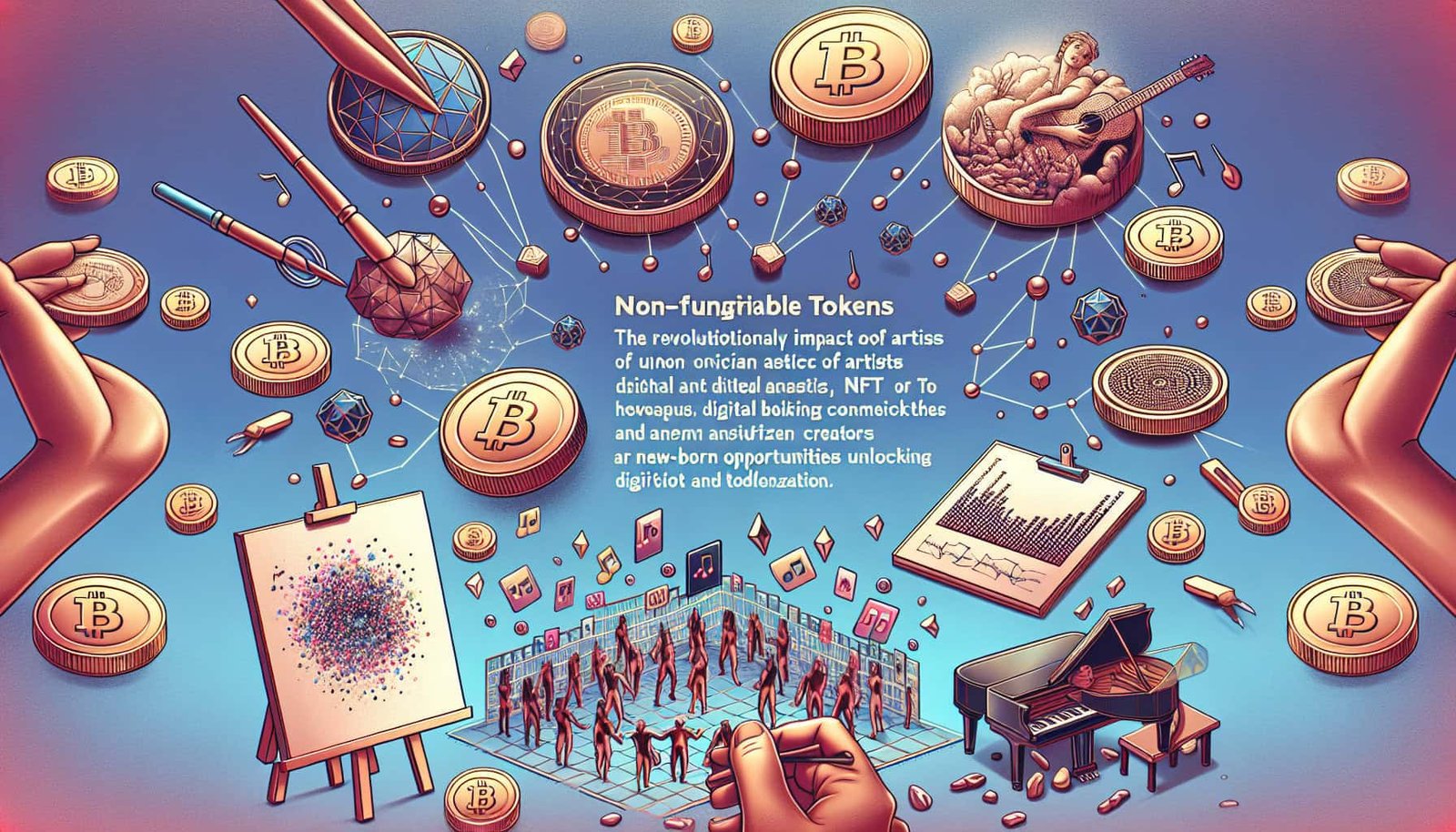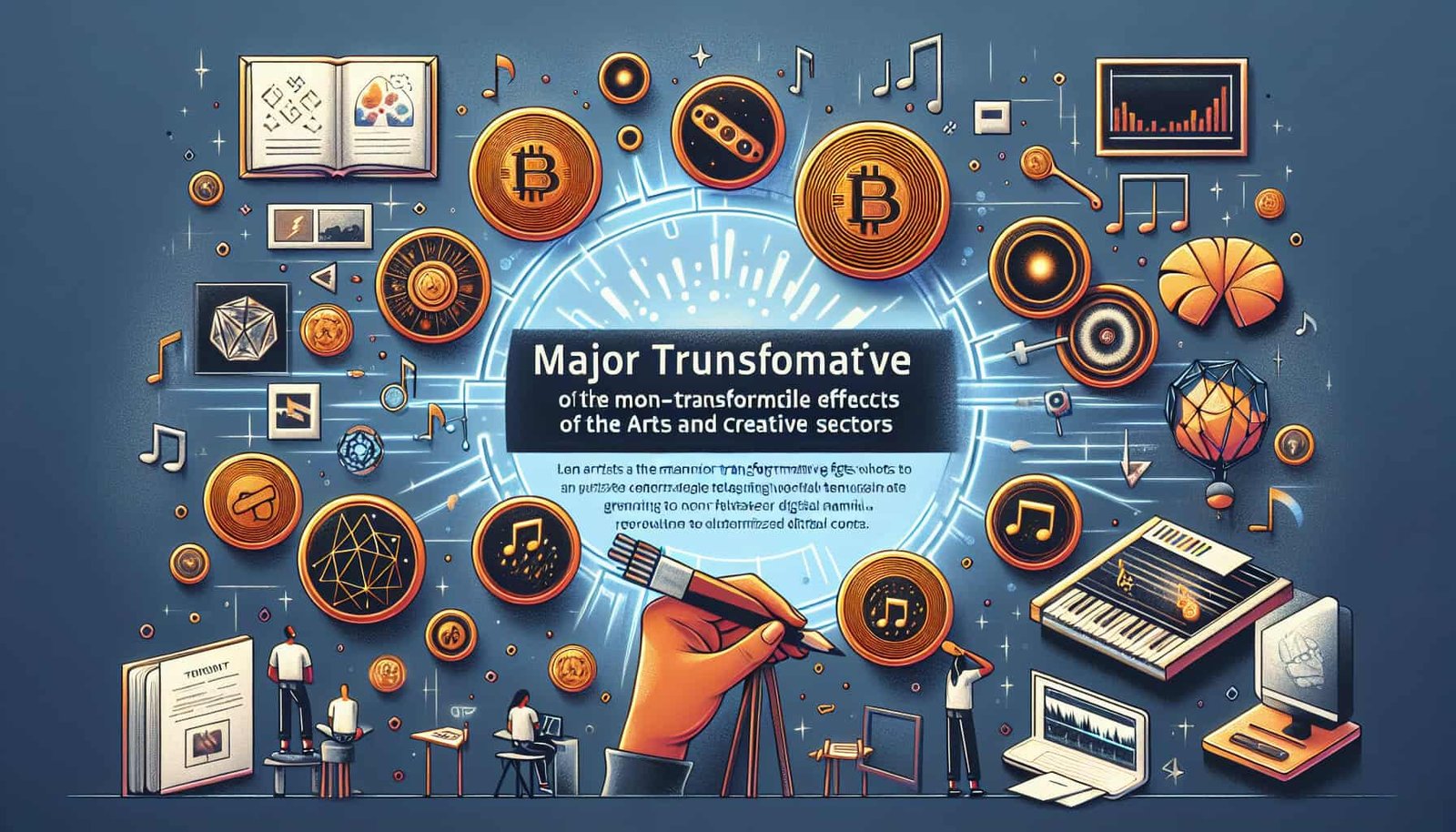In the digital age, artists and creators are finding new and innovative ways to monetize their digital content. One such method gaining traction is the use of Non-Fungible Tokens (NFTs). By leveraging blockchain technology, artists can establish verifiable ownership and scarcity of their digital creations, allowing them to sell these unique items as collectibles. From digital artwork to music and even virtual real estate, NFTs are revolutionizing the way artists can profit from their creativity. Join us as we explore how artists and creators are harnessing the power of NFTs to monetize their digital content and pave the way for a new era of artistic entrepreneurship.
How Are Artists And Creators Using NFTs To Monetize Digital Content?
What are NFTs?
NFTs, or non-fungible tokens, are a type of digital asset that represents ownership or proof of authenticity of a unique item or piece of content. Unlike cryptocurrencies such as Bitcoin or Ethereum, which are interchangeable and can be exchanged on a one-to-one basis, NFTs are individual units that cannot be replicated or replaced. They are stored on a blockchain, a decentralized digital ledger that ensures transparency and security.
Overview of the digital content market
The digital content market has experienced exponential growth in recent years. With the rise of the internet and the proliferation of digital platforms, artists and creators now have unprecedented opportunities to showcase and distribute their work to a global audience. However, this rapid expansion has also come with its fair share of challenges, including a lack of sustainable revenue streams and issues of copyright infringement.
Emergence of NFTs in the art world
NFTs have garnered significant attention in the art world, revolutionizing the way artists monetize their digital creations. Traditionally, artists have struggled to earn income from their digital artwork due to the ease of duplication and distribution. NFTs provide a solution by allowing artists to tokenize their work, establishing a unique digital certificate of ownership that can be bought, sold, and traded. This has opened up new possibilities for artists to generate income while maintaining control over their creations.
Advantages of NFTs for artists and creators
NFTs offer several advantages for artists and creators looking to monetize their digital content. Firstly, by selling their work as NFTs, artists can directly receive payments for their creations without relying on intermediaries such as galleries or agents. This allows artists to have more control over their pricing and revenue. Secondly, NFTs provide a level of authenticity and provenance to digital assets, reducing the risk of counterfeit or unauthorized copies. Lastly, NFTs enable artists to earn royalties every time their work is resold on the secondary market, providing an ongoing source of income.
NFTs: Understanding the Basics
Definition of NFTs
NFTs, short for non-fungible tokens, are digital assets that use blockchain technology to establish ownership and authenticity of unique items or pieces of content. Each NFT is tokenized and stored on a decentralized ledger, making it verifiable and transparent. Unlike cryptocurrencies, NFTs cannot be exchanged on a one-to-one basis as each token represents a distinct, non-replaceable item.
How do NFTs work?
NFTs work by utilizing blockchain technology, which serves as a secure digital ledger to record and verify transactions. When an artist creates an NFT, a unique digital certificate is generated, linking the token to a specific piece of content. This certificate contains metadata that details the ownership, provenance, and other relevant information about the digital asset. The NFT can then be bought, sold, or traded on various platforms, with each transaction recorded on the blockchain.
Different types of NFTs
NFTs can represent a wide range of digital content, including artwork, collectibles, music, videos, virtual real estate, and more. Each type of NFT has its unique characteristics and potential for monetization. For example, art NFTs allow artists to showcase their digital artwork as limited editions or one-of-a-kind pieces. Collectible NFTs can represent virtual items or characters in video games, creating a unique and valuable digital ownership experience.
Blockchain technology and NFTs
Blockchain technology serves as the foundation for NFTs, providing a decentralized and transparent system for recording and validating transactions. The blockchain ensures that each NFT is unique and can be easily tracked and verified. It also enables secure ownership transfers and transaction history, removing the need for intermediaries and reducing the risk of fraud or counterfeit copies. The use of blockchain technology for NFTs also extends beyond the art world, with applications in areas such as finance, supply chain management, and digital identity verification.

Current State of the Digital Content Market
Growth of the digital content market
The digital content market has experienced unprecedented growth in recent years, driven by advancements in technology and increasing internet connectivity. Artists and creators now have the ability to reach a global audience instantly through online platforms and social media. According to a report by Statista, the global digital content market is expected to reach a value of $432.7 billion by 2026, reflecting the immense potential for monetization in the digital space.
Challenges faced by artists and creators
Despite the growth of the digital content market, artists and creators still face significant challenges in monetizing their work. The ease of replicating and distributing digital content has made it difficult to establish value and monetization opportunities. Additionally, the centralized nature of traditional platforms and gatekeepers often limit artists’ control over pricing, royalties, and access to their audience. These challenges have led to a need for innovative solutions that empower artists to regain control over their digital creations.
Copyright issues in the digital realm
Copyright infringement has been a long-standing issue in the digital realm, with artists and creators struggling to protect their work from unauthorized use and reproduction. The decentralized nature of NFTs, combined with blockchain technology, offers potential solutions to this problem. By tokenizing their work as NFTs, artists can establish proof of ownership and traceability, making it easier to enforce copyright and protect against unauthorized copying.
Need for sustainable revenue streams
One of the key challenges for artists and creators in the digital content market is the need for sustainable revenue streams. The traditional model of selling physical copies or licensing rights to their work is no longer sufficient in the digital age. NFTs provide an innovative solution by allowing artists to directly monetize their digital creations through token sales, royalties from secondary market transactions, and collaborations with brands and platforms.
Artists and Creators Embracing NFTs
Artwork and collectibles as NFTs
Artists have been quick to embrace NFTs as a new way to showcase and monetize their digital artwork. By tokenizing their art as NFTs, artists can sell their work directly to collectors and art enthusiasts, bypassing the traditional gallery system. These NFT art pieces often come with additional benefits, such as limited editions, unlockable content, and exclusive access to the artist. Collectibles, such as virtual trading cards or in-game items, have also seen a surge in popularity as NFTs, with artists creating unique and valuable digital ownership experiences.
Virtual exhibitions and experiences
NFTs have also enabled artists to create immersive virtual exhibitions and experiences that go beyond the traditional physical gallery space. With the use of virtual reality (VR) and augmented reality (AR) technologies, artists can showcase their work in virtual environments, allowing viewers to engage with the art in new and interactive ways. NFTs can be used to provide access to these virtual exhibitions, granting collectors a unique digital experience and enhancing the value of the artwork.
Tokenization of music and audio content
Beyond visual art, musicians and audio content creators have also started to explore the potential of NFTs. By tokenizing their music or audio content, artists can offer exclusive access to unreleased tracks, live performances, or behind-the-scenes content. NFTs can be used to establish ownership and authenticity of these digital assets, enabling artists to directly monetize their music and build a closer connection with their fans. This has the potential to revolutionize the traditional music industry, where artists often struggle to earn a fair income from streaming platforms.
NFTs in the world of digital fashion
An emerging trend in the NFT space is the tokenization of digital fashion. Virtual fashion brands and designers are creating unique digital clothing and accessories that can be bought, sold, and worn exclusively in virtual environments. These digital fashion items can be tokenized as NFTs, allowing users to express their individuality and style in virtual worlds, social media, or even in certain video games. The ownership and scarcity of these digital fashion items add value and exclusivity, providing new opportunities for both fashion creators and consumers.

Benefits of NFTs for Artists and Creators
Direct monetization opportunities
One of the key benefits of NFTs for artists and creators is the ability to directly monetize their digital content. By selling their work as NFTs, artists can receive payments instantly without the need for intermediaries, such as galleries or agents. This empowers artists to have more control over their pricing and revenue, ensuring a fairer distribution of income. Additionally, the transparent nature of blockchain technology ensures that artists’ royalties from secondary market sales are automatically distributed, creating ongoing revenue streams.
Ownership and provenance of digital assets
NFTs provide a secure and verifiable way to establish ownership and provenance of digital assets. By tokenizing their work, artists can guarantee the authenticity and uniqueness of their creations, reducing the risk of counterfeit copies or piracy. This is particularly important in the digital realm, where it is difficult to establish the originality of digital content. NFTs serve as a digital certificate of authenticity, providing peace of mind for both artists and collectors.
Royalties and secondary market sales
Unlike traditional art sales, where artists generally receive a one-time payment, NFTs enable artists to earn ongoing royalties from secondary market sales. Each time an NFT is resold, the artist can receive a percentage of the sale price. This provides artists with a sustainable revenue stream, even as their work increases in value over time. The transparent and immutable nature of blockchain technology ensures that these royalties are automatically distributed, eliminating the need for complicated contracts or negotiations.
Enhanced artist-fan engagement
NFTs have the potential to enhance the relationship between artists and their fans, creating a closer and more interactive connection. By tokenizing their work, artists can offer unique benefits and experiences to NFT holders, such as exclusive access to events, behind-the-scenes content, or collaborations. This fosters a sense of community and loyalty among fans, as they become part of a select group that owns and supports the artist’s work. NFTs also enable artists to directly engage with their audience through virtual exhibitions, interactive experiences, or even gamified elements.
Discovering New Revenue Streams
Auctioning and selling NFTs
NFTs have opened up new avenues for artists and creators to auction and sell their work. Online marketplaces and platforms dedicated to NFTs provide artists with a global audience and a direct means of connecting with collectors. These platforms often use a bidding system, allowing artists to set minimum prices and receive bids for their NFTs. Auctions can generate significant buzz and competition among collectors, driving up the value of the artwork and leading to lucrative sales.
Exclusive content and limited editions
Artists can leverage the scarcity and exclusivity of NFTs to create additional value for their work. By offering limited editions or exclusive content, artists can generate higher demand and prices for their NFTs. For example, an artist may tokenize a digital artwork and offer a limited number of copies for sale. Collectors who own these limited editions gain a sense of uniqueness and prestige, as they are part of a small group of individuals who own a particular version of the artwork.
Licensing and collaborations
NFTs can also serve as a platform for artists to explore licensing and collaborations with brands, platforms, or other artists. By tokenizing their work, artists can establish digital ownership rights and negotiate partnerships that offer additional revenue streams. This could include licensing their digital creations for use in virtual reality experiences, video games, or even as digital collectibles tied to physical products. Collaborations with other artists or brands can also bring added exposure and opportunities for cross-promotion.
Virtual real estate and virtual world sales
In virtual worlds and metaverses, NFTs can represent ownership of virtual real estate, virtual objects, or even digital avatars. Artists and creators can leverage this opportunity by tokenizing and selling virtual assets within these virtual environments. This includes selling virtual land, buildings, or unique digital objects that enhance the user’s experience within the virtual world. As virtual worlds continue to evolve and gain popularity, the market for virtual assets represented as NFTs also expands, providing artists and creators with new and unique revenue streams.

NFT Platforms and Marketplaces
Top NFT platforms for artists and creators
Several platforms have emerged as major players in the NFT space, providing artists and creators with the infrastructure to tokenize and sell their digital content. Some of the top NFT platforms include:
OpenSea: OpenSea is one of the largest NFT marketplaces, offering a wide range of digital assets, including artwork, virtual land, and gaming items.
Rarible: Rarible is a decentralized marketplace that allows artists to create, buy, and sell NFTs with minimal fees and restrictions.
SuperRare: SuperRare focuses on digital art, offering a curated selection of high-quality, limited-edition NFTs.
Foundation: Foundation is an invite-only platform that showcases curated artwork and allows artists to sell their NFTs through auction-based sales.
Established art marketplaces embracing NFTs
In addition to dedicated NFT platforms, established art marketplaces have also started embracing NFTs as a new medium for artists to monetize their work. Some notable examples include:
Christie’s: Christie’s, one of the world’s leading auction houses, has hosted successful NFT sales, including the historic auction of Beeple’s artwork.
Sotheby’s: Sotheby’s, another prominent auction house, has also joined the NFT trend, showcasing and selling digital art on their platform.
Art Basel: Art Basel, one of the most prestigious art fairs, has incorporated NFTs into its programming, featuring virtual exhibitions and discussions on the topic.
Features and criteria to consider
When choosing an NFT platform or marketplace, artists and creators should consider several factors. These include the platform’s user interface and ease of use, accessibility and inclusivity, fees and revenue sharing models, community and audience reach, and the platform’s commitment to sustainability and environmental impact. It is important to research and explore different platforms to find the one that best aligns with an artist’s goals and values.
Risks and challenges in the NFT space
While NFTs offer exciting opportunities for artists and creators, it is essential to acknowledge the risks and challenges associated with this emerging technology. Some of the key concerns include market volatility, where prices for NFTs can fluctuate dramatically, potentially leading to financial loss. Additionally, the lack of regulation and standards in the NFT space can make it challenging to navigate legal and copyright issues. Artists and creators should also be mindful of the environmental impact of NFTs, as the energy consumption associated with blockchain transactions has raised concerns about sustainability.
Navigating Copyright Issues in the NFT Space
Copyright ownership and validation
Copyright ownership plays a vital role in the NFT space, as it determines the rights and permissions associated with a digital asset. Artists and creators should ensure they hold the necessary copyright or licenses for the content they tokenize as NFTs. Validation of copyright ownership can be established through proper documentation, registration with copyright authorities, or the use of blockchain-based timestamping services. These measures help protect artists from copyright disputes and ensure that their work is treated with the respect it deserves.
Protecting against IP infringement
NFTs can offer some level of protection against intellectual property (IP) infringement, as the ownership and provenance of digital assets are recorded on the blockchain. However, artists and creators should remain vigilant in monitoring and enforcing their IP rights. This includes regularly searching NFT marketplaces for unauthorized copies of their work, issuing takedown notices when necessary, and considering legal action against infringers. Collaboration with legal professionals specializing in intellectual property law can provide valuable guidance and protection.
Legal considerations for artists and creators
Artists and creators should be aware of the legal considerations involved in the NFT space to protect their rights and interests. These considerations may include intellectual property rights, contractual agreements, tax implications, and compliance with local laws and regulations. Engaging legal counsel experienced in digital art, blockchain, and NFTs can help artists navigate the legal landscape, ensuring that they understand their rights and obligations as they monetize their digital content.
Building a fair and transparent ecosystem
As the NFT space continues to evolve, there is a growing need for a fair and transparent ecosystem that benefits both artists and collectors. This includes establishing standard practices for royalties, ensuring clear ownership structures, and enhancing the transparency of transactions and provenance. Artists, platforms, and industry stakeholders should work together to create guidelines and best practices that promote a sustainable and ethical marketplace for NFTs, ensuring the long-term viability of the technology for artists and creators.

Case Studies: Successful NFT Monetization
Beeple’s groundbreaking NFT sale
One of the most notable examples of successful NFT monetization is the sale of Beeple’s artwork, titled “Everydays: The First 5000 Days,” which sold for a staggering $69.3 million at a Christie’s auction. This groundbreaking sale brought global attention to NFTs and demonstrated the immense value that collectors place on digital art. The auction not only established Beeple as one of the most prominent digital artists but also highlighted the potential for artists to earn significant income through NFT sales.
Musician’s NFT album release
Artists in the music industry have also embraced NFTs as a means to monetize their work. In March 2021, the musician Kings of Leon released their latest album as an NFT, offering exclusive content, artwork, and concert perks to NFT buyers. This innovative approach allowed the band to generate substantial revenue while offering fans a unique and immersive music experience. The success of Kings of Leon’s NFT album release paved the way for other musicians to explore similar monetization models.
Virtual fashion brands and collaborations
Virtual fashion brands and collaborations have flourished in the NFT space, showcasing the potential for digital fashion as a new market. In 2020, the digital fashion brand “The Fabricant” sold a one-of-a-kind virtual dress as an NFT, fetching a significant price of $9,500. This highlighted the demand for unique and collectible digital fashion items. Collaborations between fashion brands, artists, and gaming platforms have also gained traction, with major fashion houses tokenizing their designs as NFTs and partnering with virtual worlds to reach broader audiences.
Artists leveraging virtual exhibitions
NFTs have enabled artists to create virtual exhibitions and immersive experiences that transcend physical limitations. In early 2021, the virtual exhibition “CryptoPunks” took the art world by storm, showcasing a collection of 10,000 unique, algorithmically generated characters. Each of these characters was tokenized as an NFT and successfully sold to collectors. This virtual exhibition demonstrated the power of NFTs to engage audiences in novel ways, where visitors could explore, buy, and own digital artwork within a virtual space.
Challenges and Future Outlook
Environmental concerns of NFTs
One of the significant challenges associated with NFTs is the environmental impact of blockchain technology. The energy consumption required for blockchain transactions, particularly on platforms like Ethereum, has raised concerns about sustainability. Artists and creators must be mindful of this issue and seek platforms and marketplaces that prioritize energy efficiency and utilize more sustainable blockchain options. The industry as a whole should work towards developing greener solutions to reduce the carbon footprint associated with NFT transactions.
Market volatility and bubble speculation
The rapid growth of the NFT market has led to concerns about market volatility and potential bubble-like behavior. Prices for NFTs can fluctuate dramatically, leading to uncertainties for both artists and collectors. It is essential for artists to approach the NFT space with a long-term mindset, focusing on building a strong body of work and fostering meaningful connections with their audience. Collectors should also conduct thorough research and due diligence before investing in NFTs to make informed decisions.
Lack of inclusivity and accessibility
While NFTs have created opportunities for artists to monetize their digital content, there are concerns about the lack of inclusivity and accessibility in the space. High transaction fees and the need for cryptocurrency wallets can create barriers for artists and collectors, particularly those who are new to blockchain technology. Platforms and marketplaces should strive to lower barriers to entry, provide educational resources, and explore alternative payment options to ensure broader participation and representation in the NFT ecosystem.
Exploring potential regulations and standards
As the NFT space continues to evolve, there is a growing need for regulations and standards to protect the rights and interests of artists, collectors, and platforms. Developing clear guidelines for copyright ownership, royalties, and secondary market transactions can create a fair and transparent ecosystem. Regulatory bodies and industry organizations should collaborate with artists, legal experts, and technology innovators to establish best practices that promote ethical, sustainable, and responsible use of NFTs.
In conclusion, NFTs have revolutionized the way artists and creators monetize their digital content by providing direct monetization opportunities, establishing ownership and provenance of digital assets, enabling royalties and secondary market sales, and enhancing artist-fan engagement. The growth of the digital content market, coupled with the challenges faced by artists in traditional revenue streams, has made NFTs an attractive solution for the creative community. However, it is important to navigate the NFT space with awareness of legal considerations, environmental impact, and potential market volatility. By addressing these challenges and working towards a fair and transparent ecosystem, artists, creators, and collectors can continue to shape the future of digital content monetization through NFTs.


